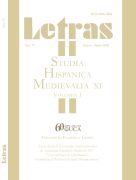Please use this identifier to cite or link to this item:
https://repositorio.uca.edu.ar/handle/123456789/3613| Título: | Las máscaras de Trotaconventos : retórica, emociones y mediación en el Libro de buen amor Trotaconventos' masks : rhetoric, emotions, and mediation in the Libro de buen amor |
Autor: | Palafox, Eloísa | Palabras clave: | Ruiz, Juan, Arcipreste de Hita; LITERATURA ESPAÑOLA; LITERATURA MEDIEVAL; RETORICA; ETICA; EMOCION; NEUROCIENCIA | Fecha de publicación: | 2018 | Editorial: | Universidad Católica Argentina. Facultad de Filosofía y Letras | Cita: | Palafox, Eloísa. “Las máscaras de Trotaconventos : retórica, emociones y mediación en el Libro de buen amor” [en línea]. Letras, 77 (2018). Disponible en: https://repositorio.uca.edu.ar/handle/123456789/3613 | Resumen: | Resumen: En este artículo se presenta un análisis de los engaños discursivos de que se sirve Trotaconventos para tratar de convencer a sus interlocutoras de que correspondan a los requerimientos amorosos del arcipreste. Como aquí veremos, todos estos engaños se apoyan, de una u otra forma, en la caracterización que hace la alcahueta de sí misma en términos morales, sirviéndose de una serie de imágenes y exempla que, al pasar por el crisol de su lengua, adquieren nuevas connotaciones y significados. Para apoyar mi lectura, utilizaré algunos conceptos desarrollados a la luz de ciertos descubrimientos recientes hechos en el campo de las neurociencias a propósito de los orígenes y la naturaleza de la raza humana, y de la forma como éstos influyen en la formación de nuestras ideas morales. Esos conceptos me permitirán explicar las razones por las cuales, a pesar de todas las advertencias y precauciones que el Libro contiene, quienes se exponen al contacto con sus “fablares fermosos” y los de sus personajes no pueden evitar seguir corriendo un alto riesgo de acabar siendo víctimas de sus engaños. Abstract: This article presents an analysis of the deceitful discourse used by Trotaconventos to try to convince her listeners to accept the Archpriest’s amorous requests. As we will see here, the point of departure of this discourse is the characterization the go-between makes of herself in moral terms. She achieves this successful self-portrait using a series of images and exempla whose meanings and connotations she modifies at will, to best serve her deceitful goals. To support my argument I will use some concepts taken from a set of recent discoveries made in the field of the neurosciences that point towards a more accurate and scientific description of the origins and nature of our own human race, and the way these have given shape to our moral ideas. Those concepts will help me explain the reasons why, despite all the Book’s warnings and admonishments, whoever gets exposed to its “fablares fermosos” (beautiful talk) and that of its characters cannot avoid running a high risk of falling prey of their traps. |
URI: | https://repositorio.uca.edu.ar/handle/123456789/3613 | ISSN: | 0326-3363 | Disciplina: | LITERATURA | Derechos: | Acceso Abierto | Fuente: | Letras Nº 77, 2018 |
| Appears in Collections: | LETRAS - 2018 nro. 77 |
Files in This Item:
| File | Description | Size | Format | |
|---|---|---|---|---|
| mascaras-trotaconventos-retorica-palafox.pdf | 194,42 kB | Adobe PDF |  View/Open |
Page view(s)
186
checked on Apr 30, 2024
Download(s)
239
checked on Apr 30, 2024
Google ScholarTM
Check
This item is licensed under a Creative Commons License

